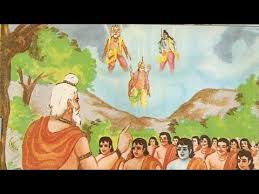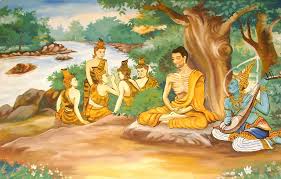Vedic period civilization
Early Vedic Or Rigvedic Period

• Monarchial form, tribe was known as Jan and its king as RaJan He was the leader in battle and protector of tribe. His office was not hereditary and was selected among the clan’s men. The rajan was not an absolute monarch, for the government of the tribe was in part the responsibility of the tribal councils like sabha, samiti, gana and vidhata. Even women attended sabha and vidhata.
• Many clans (Vish) formed a tribe. The basic social unit was the Kula or the family and Kulapa was the head of the family.
• The king was assisted by a number of officers of which purohita was the most important. Next important functionary was the Senani (leader of the army), although there was no regular or standing army. The military
technique of the early Aryans was much advanced. The Aryans succeeded everywhere because they possessed chariots driven by horses.
• There was no regular revenue system and the kingdom was maintained by the voluntary tribute (Bali) of his subjects and the booty won in battle.
• Villages were headed by Gramini who used to represent village in sabha and samiti. Later, Gramini was handed over the charge of Vrajapati also (an officer who enjoyed authority over the pasture ground).
Early Vedic Or Rigvedic Period : Social Life :

• When the Aryans entered India there was already a class division in their tribal structure.
• As they settled among the dark aboriginals, the Aryans seem to have laid greater stress than before on purity of blood, and class divisions hardened, to exclude those dasas who had found a place in the Aryan society, and those Aryans who had intermarried with the dasas and adopted their ways.
• Gradually, the tribal society got divided into three groups warriors, priests and commoners. Later, the fourth dasas or shudra was also added.
• The term varna was used for color, the Aryans being fair, the dasas dark.
• Family was the basic unit of society. The family was patriarchal in nature. But women enjoyed equal power with men. Marriage was usually monogamous and indissoluble, but there are few instances of polyandry, levirate and widow-marriage. There are no examples of child-marriage. The marriageable age seems to have been 16 to 17.
• The word ‘Arya’ came to refer to any person who was respected.
• Aryans were fond of soma, sura, food and dresses. Soma was drunk at sacrifices and its use was sanctified by religion. Sura was purely secular and more potent, and was diapproved by the priestly poets.
• The Aryans loved music, and played the flute, lute and harp. There are references to singing and dancing, and to dancing girls. People also delighted in gambling. They enjoyed chariot racing. Both men and women wore ornaments.
Early Vedic Or Rigvedic Period : Economy :
• Their bronze smiths were highly skilled, and produced tools and weapons much superior to those of Harappan
culture. There were artisans like carpenters, weavers, cobblers, potters, etc.
• Aryans followed a mixed economy – pastoral and agricultural – in which cattle played a predominant part.
• Most of their wars were foughtfor cow (most important form of wealth). Cattle were in fact a sort of currency, and values were reckoned in heads of cattle (man’s life was equivalent to that of 100 cows), but they were not held sacred at this time. The horse was almost as important as the cow.
• Standard unit of exchange was cow. At the same time coins were also there (gold coins like Nishkq, Krishnal and Satmana).
• Gavyuti was used as a measure of distance and Godhuli as a measure of time.
• Lived in fortified mud settlements.
• Physicians were there called ‘Bhishakas’.
• The staple crop was ‘yava’, which meant barley.
Vedic Period Religion
• The Aryans personified the natural forces and looked upon them as living beings.
• The most important divinity was Indra who played the role of warlord (breaker of forts – Purandar, also associated
with storm and thunder).
• The second position was held by Agni (fire-god). He is considered as an intermediary between gods and men.
• Varuna occupied the third position. He personified water and was supposed to uphold the natural order. He was
ethnically the highest of all Rigvedic gods.
• Soma was considered to be the god of plants. Maruts personified the storms. Some female deities are also
mentioned, like Aditi and Usha, who represented the appearance of dawn.
• Didn’t believe in erecting temples or idol worship. Worshipped in open air through yajnas.
Vedic Texts
Linguistically, the texts belonging to the Hindu Vedic Civilisation can be classified into the following five chronological branches
Rigvedic
The oldest text of the Vedic Period, Rig Veda has many elements that are common with the Indo-Iranian texts, both in language and in content.One cannot find such similarity in any other Vedic text. It is believed that the compilation of the Rig Veda had stretched over a number of centuries. However, there is a conflict as to the
completion date of the Rig Veda. Some historians believe it to be 1500 BC, while the others believe it to be 3000 BC. This time period coincided with the Indus Valley Civilization.
Mantra Language
The period of the Mantra Language includes the time of the compilation of the mantra and prose language of the Atharvaveda (Paippalada and Shaunakiya), the Rigveda Khilani, the Samaveda Samhita and the mantras of the Yajurveda. Though derived from the Rig Veda, all these texts experienced wide scale changes, in terms of language as well as at the time of reinterpretation. This time period coincided with the early Iron Age in northwestern India and the Black and Red Ware culture.
Samhita Prose
The period of Samhita Prose represents the compilation and codification of a Vedic canon. The linguistic changes of this time include the complete loss of the injunctive, the subjunctive and the aorist. The commentary part of the Yajurveda belongs to the Samhita Prose period. During this time, the Painted Grey Ware culture
was evident.
Brahmana Prose
This period signifies Brahmanas proper of the four Vedas, along with the oldest Upanishads
Sutra Language
The last division of the Vedic Sanskrit can be traced upto 500 BC. During this time, a major portion of the Srauta Sutras, the Grihya Sutras and some Upanishads were composed. Epic and Paninian Sanskrit (Post Vedic) In the post-Vedic Period, the compilation of Mahabharata and Ramayana epics took place. The Classical Sanskrit described by Panini also emerged after the Vedic Age. The Vedanta and the Pali Prakrit dialect of Buddhist scripture belong to this period. During this time, the
Northern Black Polished Ware culture started spreading over the northern parts of India. The end of the Vedic Period Civilization in India was marked by significant changes in the field of linguistics, culture and politics. With the invasion of the Indus valley by Darius I, in the 6th century, outside influences started creeping
in.
Political Organization
The political units during the Rigvedic or the early Vedic period comprised of Grama (village), Vish and Jana. The biggest political unit was that of Jana, after which came Vish and then, Grama. The leader of a Grama was called Gramani, of a Vish was called Vishpati and that of Jana was known as Jyeshta. The rashtra
(state) was governed by a Rajan (King) and he was known as Gopa (protector) and Samrat (supreme ruler). The king ruled with the consent and approval of the people. There were four councils, namely Sabha, Samiti, Vidhata and Gana, of which women were allowed to attend only two, Sabha and Vidhata. The duty of the king was to protect the tribe, in which he was assisted by the Purohita (chaplain) and the Senani (army chief).
Later Vedic Period
The later Vedic Period commenced with the emergence of agriculture as the principal economic activity. Along with that, a declining trend was experienced as far as the importance of cattle rearing was concerned. Land and its protection started gaining significance and as a result, several large kingdoms arose.
Later Vedic Period : Political Organization
The rise of sixteen Mahajanapadas, along with the increasing powers of the King, comprise of the other characteristics of this period. Rituals like rajasuya, (royal consecration), vajapeya (chariot race) and ashvamedha (horse sacrifice) became widespread. At the same time, the say of the people in the administration diminished.
Later Vedic Period : Society
As far as the society is concerned, the concept of Varna and the rules of marriage became much more rigid than before. The status of the Brahmanas and Kshatriyas increased greatly and social mobility was totally restricted. The proper pronunciation of verses became to be considered as essential for prosperity and success in war. Kshatriyas started amassing wealth and started utilizing the services of the Brahmins. The other castes were slowly degraded. Around 500 BC, the later Vedic Period started giving rise to the period of the Middle kingdoms of India.



